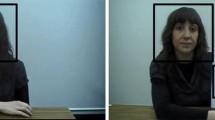Abstract
The present study compared two classroom-relevant procedures for remediating visual overselectivity in autistic children. One approach was based on perceptualmotor theory in which possible relationships between functional object-use and overselectivity were studied. The second strategy, equivalence training, used a four-step stimulus shift procedure. A comparison group of autistic children was exposed to simple repeated practice trials with the test tasks. Results showed that equivalence training was more effective than functional object-use in improving posttest scores, with repeated practice falling in between. The results are discussed in terms of theoretical and practical issues relating to stimulus overselectivity, including the incorporation of microcomputer technology.
Similar content being viewed by others
References
American Psychiatric Association. (1980).Diagnostic and statistical manual of mental disorders (3rd ed.). Washington, D.C.: Author.
Bailey, S. L. (1981). Stimulus overselectivity in learning disabled children.Journal of Applied Behavior Analysis, 14, 239–248.
Bruner, J. S. (1966).Toward a theory of instruction. New York: Norton.
Etzel, B. C., & LeBlanc, J. M. (1979). The simplest treatment alternative: The law of parsimony applied to choosing appropriate instructional control and errorless learning procedures for the difficult-to-teach child.Journal of Autism and Developmental Disorders, 9, 361–382.
Gersten, R. M. (1980). In search of the cognitive deficit in autism: Beyond the stimulus overselectivity model.Journal of Special Education, 14, 49–65.
Gibson, E. J. (1969).Principles of Perceptual Learning and Development. New York: Appleton-Century-Crofts.
Grimes, L. (1981). Error analysis and error correction procedures.Teaching Exceptional Children, 14(1), 17–20.
Kephart, N. C. (1971).The slow learner in the classroom (2nd ed.). Columbus, Ohio: Charles E. Merrill.
Koegel, R. L., Dunlap, G., & Dyer, K. (1980). Intertrial interval duration and learning in autistic children.Journal of Applied Behavior Analysis, 13, 91–99.
Koegel, R. L., & Schreibman, L. (1977). Teaching autistic children to respond to simultaneous multiple cues.Journal of Experimental Child Psychology, 24, 299–311.
Koegel, R. L., Schreibman, L., Britten, K., & Laitinen, R. (1979). The effects of schedule of reinforcement on stimulus overselectivity in autistic children.Journal of Autism and Developmental Disorders, 9, 383–397.
Koegel, R. L., & Wilhelm, H. (1973). Selective responding to the components of multiple visual cues.Journal of Experimental Child Psychology, 15, 442–453.
Kovattana, P. M., & Kraemer, H. C. (1974). Response to multiple visual cues of color, size, and form by autistic children.Journal of Autism and Childhood Schizophrenia, 4, 251–261.
Lawrence, D. H. (1950). Acquired distinctiveness of cues: II. Selective association in a constant stimulus situation.Journal of Experimental Psychology, 40, 175–188.
Lovaas, O. I., & Koegel, R. L. (1973). Behavior therapy with autistic children. In C. E. Thoresen (Ed.),Seventy-second yearbook of the National Society for the Study of Education. Part II; Behavior modification in education (pp. 230–258). Chicago: University of Chicago Press.
Lovaas, O. I., & Schreibman, L. (1971). Stimulus overselectivity of autistic children in a two stimulus situation.Behaviour Research and Therapy 9, 305–310.
Lovaas, O. I., Schreibman, L., Koegel, R. L., & Rehm, R. (1971). Selective responding by autistic children to multiple sensory input.Journal of Abnormal Psychology 77, 211–222.
Montessori, M. (1964).The Montessori method (A. E. George, Trans.). New York: Schocken Books. (Original work published 1912)
Piaget, J., & Inhelder, B. (1969).The psychology of the child. New York: Basic Books.
Reynolds, B. S., Newsom, C. D., & Lovaas, O. I. (1974). Auditory overselectivity in autistic children.Journal of Abnormal Child Psychology, 4, 253–263.
Rincover, A. (1978). Variables affecting stimulus-fading and discriminative responding in psychotic children.Journal of Abnormal Child Psychology, 87, 541–553.
Schneider, H. C., & Salzberg, C. L. (1982). Stimulus overselectivity in a match-to-sample paradigm by severely retarded youth.Analysis and Intervention in Development Disabilities, 2, 273–304.
Schover, L. R., & Newsom, C. D. (1976). Overselectivity, developmental level and overtraining in autistic and normal children.Journal of Abnormal Child Psychology, 4, 289–298.
Schreibman, L. (1975). Effects of within-stimulus and extra-stimulus prompting on discrimination learning in autistic children.Journal of Applied Behavior Analysis, 8, 91–112.
Schreibman, L., Charlop, M. H., & Koegel, R. L. (1982). Teaching autistic children to use extra-stimulus prompts.Journal of Experimental Child Psychology, 33, 475–491.
Schreibman, L., Koegel, R. L., & Craig, M. S. (1977). Reducing stimulus overselectivity in autistic children.Journal of Abnormal Child Psychology, 5, 425–436.
Schreibman, L., & Lovaas, O. I. (1973). Overselective response to social stimuli by autistic children.Journal of Abnormal Child Psychology, 1, 152–168.
Sidman, M., & Stoddard, L. T. (1966). Programming perception and learning for retarded children. In N. R. Ellis (Ed.),International review of research in mental retardation (Vol. 2, pp. 151–208). New York: Academic Press.
Terrace, H. S. (1963). Errorless transfer of a discrimination across two continua.Journal of the Experimental Analysis of Behavior, 6, 223–232.
Wilhelm, H., & Lovaas, O. I. (1976). Stimulus overselectivity: A common feature in autism and mental retardation.American Journal of Mental Deficiency, 81, 26–31.
Author information
Authors and Affiliations
Additional information
This research was funded in part by Research Grant Number G008001901 from the U.S. Office of Education to the first author. The authors would like to express their appreciation to Michael Darcy, assistant director, Child Development Center, Smithtown, New York, for his cooperation in the implementation of this study. The authors also thank Dr. Judith Lawrence of Columbia University for her assistance in the data collection and data analysis phases of the project.
Rights and permissions
About this article
Cite this article
Hedbring, C., Newsom, C. Visual overselectivity: A comparison of two instructional remediation procedures with autistic children. J Autism Dev Disord 15, 9–22 (1985). https://doi.org/10.1007/BF01837895
Issue Date:
DOI: https://doi.org/10.1007/BF01837895




